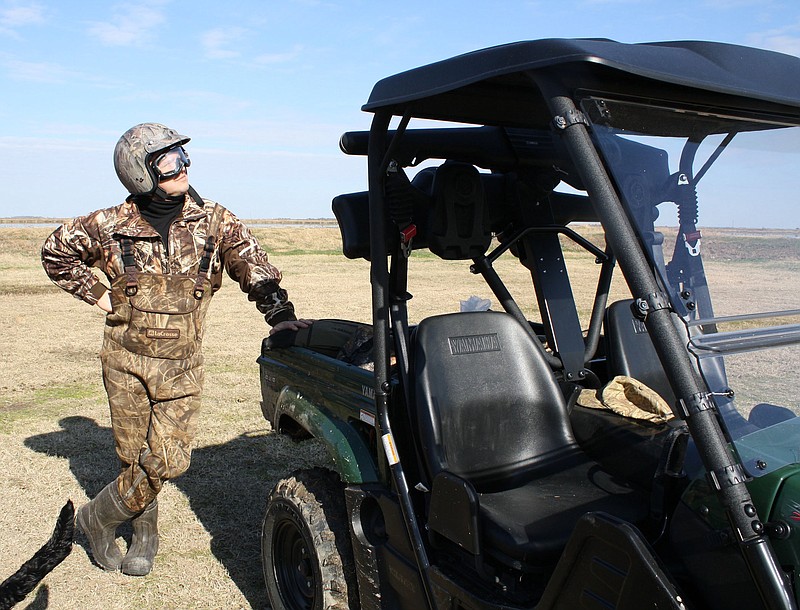A close friend nearly died in a four-wheeler accident at the end of duck season.
He was alone in the dark, removing decoys and other gear from his duck hunting lease. He is not sure how it happened, but he believes a duck decoy might have gotten wedged against his knee and throttle. The machine, a large one with a 500cc engine, took off like a rocket. My friend lost control of the steering, and he believes the machine went end over end down the side of a levee and landed on top of him.
Every rib broke. Several ribs were shattered and had to be reconstructed. One lung collapsed and the other was punctured.
Fortunately, his mobile phone remained with him during the accident. He stayed conscious and lucid enough to call for help. He nearly died at the hospital, and it took heroic medical intervention to save him.
My friend sold the four-wheeler. He will never ride another one. Instead, he said he is going to by a side-by-side, a small utility vehicle that's kind of like a golf cart on steroids. It has a roof. The front and back are usually enclosed by a windshield and a rear window. The sides on most models, especially older models, are open. Many have restraints, but riders seldom wear them.
Side-by-sides are not immune from accidents, though.
Last week, the teenage daughter of another friend, Brian Anderson, experienced a catastrophic accident while riding as a passenger in a side-by-side.
Anderson, known in outdoor circles as The Tick Terminator, is an authority on ticks, tick-borne diseases and tick-bite prevention. He said it took heroic measures to save his daughter's arm, but the arm will probably lose most of its function and that it will regain any function only through exhaustive rehabilitation.
How that accident happened is irrelevant. The fact is that a freak occurrence, irresponsibility or a moment's inattention can be catastrophic when riding on or in an off-road vehicle.
In the first incident, several factors were at play. First, my friend was alone. Hunters are often alone, especially when doing chores. It's not necessarily a bad idea to be alone, but it requires even greater vigilance, and it increases the risk in the event of a mishap.
Significantly, my friend diverged from his routine. He usually carries gear in a sled that he tows behind his four-wheeler, but he eschewed the sled on this trip. He was pressed for time and believed he could manage his gear without using a separate conveyance. Instead, he piled his gear all over the machine, which might have resulted in a decoy getting wedged between his knee and the throttle.
Whatever happened after that was so quick that he didn't have time to react. It was a classic freak accident that had no obvious cause.
Side-by-sides carry an additional risk in the form of the cab assembly. If one falls on its side, the cab frame can pin and maybe even sever a rider's limbs. A frame strike can also severely damage a rider's head.
The bottom line is that any off-road vehicle must be ridden with utmost care and caution. Riding off-road entails uneven terrain, often radically uneven terrain that can be made even more unstable by deep mud and water. It often involves riding over large obstacles, especially logs and sometimes boulders. Encountering obstacles can jerk a four-wheeler's handlebars and cause the driver to lose balance and destabilize the machine. In these situations, you can get thrown from a four-wheeler surprisingly easily at low speed.
Because of their extremely short wheel bases and narrow beams, four-wheelers and side-by-sides can easily flip during high-speed turns. At high speed on unpaved roads, they are prone to fishtailing and drifting. When this happens, it's easy to over-correct and quickly lose control of the machine.
Off-road vehicles are a lot of fun to ride, but using common sense is paramount. Don't drive fast. Avoid situations that can cause one or more wheels to leave the ground. Keep the entire area free around the throttle. Nothing should be able to touch it except for your hand. Always look ahead and plot a course that avoids large obstacles and holes. Some of my most harrowing experiences have occurred when a front wheel buried into a pit that was once occupied by a pine stump.
Finally, keep your cell phone in a secure pocket, preferably a shirt pocket or jacket pocket that zips, buttons or snaps shut. This will keep it from being flung away in the event of an accident. Extracting a phone from a trouser pocket might not be possible or extremely painful if you injure your back or ribs.
The benefits of wearing a helmet are obvious. An unprotected cranium will lose any bout with a hard object or hard surface. Protective eyewear will also protect your eyesight from contact with branches and briars.
Finally, tell a friend and family member where you are in case something bad happens.
